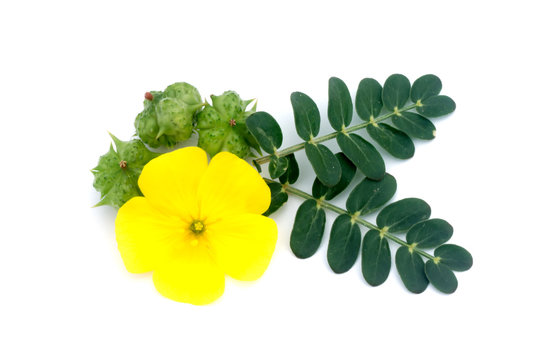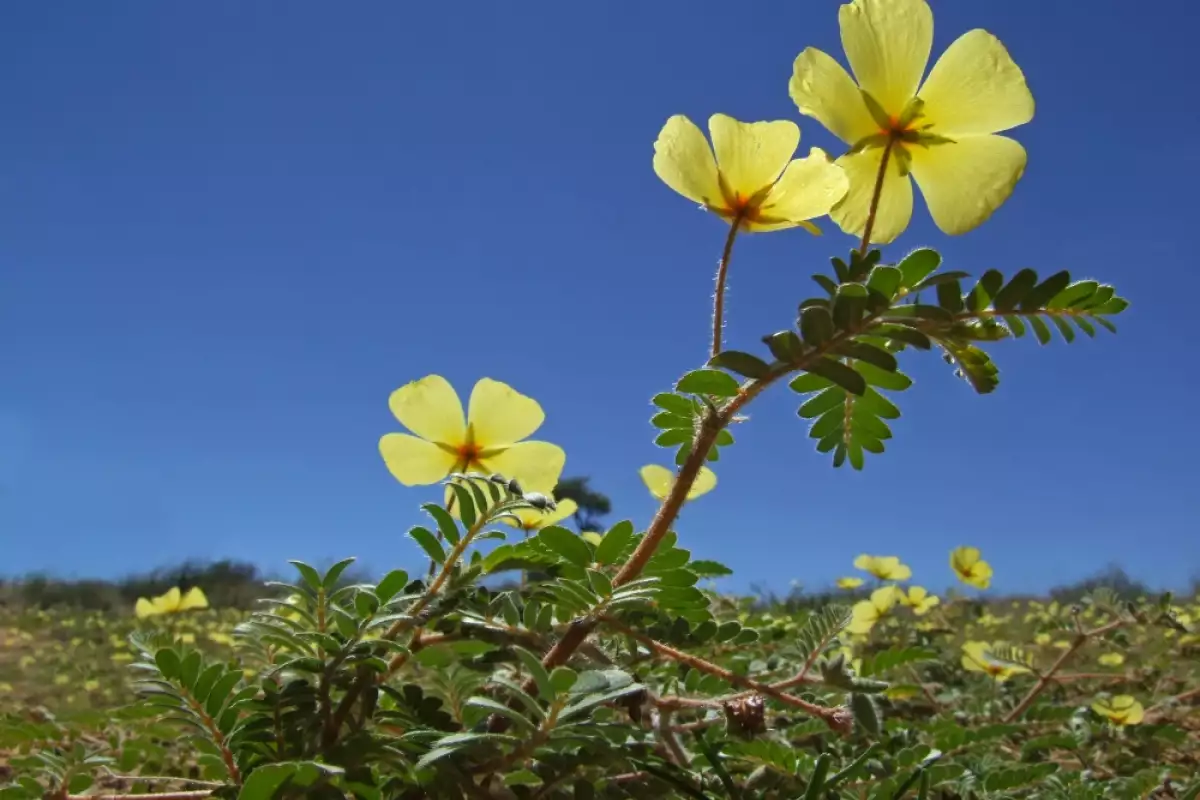In the heart of the United Arab Emirates lies a captivating national symbol – the Tribulus Omanense, a flower that is as unique and mesmerizing as the nation itself. Also known as the Al Marwah flower, this delicate beauty holds a special place in Emirati culture and history. National symbols like the Tribulus Omanense reflect the culture, history, and natural environment of the UAE, connecting the Emirati people with their heritage. Let’s embark on a journey to discover everything there is to know about the national flower of the UAE.
The Botanical Marvel: Tribulus Omanense

Source: Google
UAE national flower, Tribulus Omanense belongs to the Zygophyllaceae family, showcasing intricate white and yellow flowers. It thrives in the arid desert regions, making it a resilient symbol of the UAE’s endurance and strength in the face of adversity. This perennial herbaceous plant boasts pinnate leaves and produces spiky fruit pods that contain seeds. Its enchanting bloom and ability to thrive in challenging conditions make it an emblem of hope and prosperity.
Though Tribulus Omanense is a flower of the desert (the prime reason it’s called the national flower of UAE; it can also be found in colder environments at times.
Botanical Details
Tribulus Omanense exhibits a distinctive growth cycle tailored for desert survival. It flowers during the cooler winter months, leveraging favourable temperatures for optimal bloom while conserving moisture in arid conditions. The plant’s adaptive features, such as spiny stems and seed pods, serve dual purposes: deterring herbivores and facilitating seed dispersal. Its spiky seeds attach to animal fur, aiding in distribution across the desert landscape. This adaptation not only ensures the plant’s survival in extreme heat but also underscores its role in desert ecology and biodiversity conservation.
Rich Cultural Significance

Source: Google
In the UAE’s cultural tapestry, the Tribulus Omanense has a deep-rooted significance. Emiratis associate it with the spirit of unity and the nation’s unyielding determination to flourish, despite harsh climatic conditions. Furthermore, its enchanting presence serves as a reminder of the nation’s strong connection to its desert heritage and the resilience of its people.
Historical Significance
The choice of Tribulus Omanense as the UAE’s national flower in 1973 was a purposeful choice, symbolising unity and resilience. This decision was inspired by the flower’s remarkable adaptation to thrive in the harsh desert environment, reflecting the nation’s resilience and determination in overcoming challenges. By embracing Dubai national flower, Tribulus Omanense, as a national symbol, the UAE pays homage to its desert heritage and underscores its commitment to progress and prosperity amidst adversity.
Symbolism in Folklore and Traditions
Tribulus Omanense has woven itself into the fabric of Emirati folklore and traditions. The flower’s ability to bloom and thrive in the desert’s unforgiving conditions has inspired stories of courage, perseverance and hope. It symbolises the UAE’s commitment to progress, prosperity and embracing the challenges that lie ahead.
Tiny, Tough and Charming Flower

Source: Shutterstock
Despite its desert home, the Tribulus Omanense is a surprisingly delicate flower. Standing at just a few inches tall, it boasts fine, feathery, pinnate leaves that fold upwards during the hottest parts of the day to conserve moisture. But the true star of the show is the flower itself.
With five bright yellow petals, the Tribulus Omanense spreads its sparkle during the cooler winter months, adding a splash of colour to the dry landscape. The flower’s star-like shape and cheerful colour have earned it various nicknames such as ‘Desert Star’ and ‘Sun Coin.’
Cultural Integration
National flower of Dubai, Tribulus Omanense, is deeply woven into Emirati culture, often featured in traditional crafts and artworks. Its star-shaped form is a popular motif in embroidery, pottery, and jewellery. In literature, especially poetry, the flower symbolises resilience and beauty, frequently appearing in verses recited during cultural festivals. In daily life, the flower is sometimes used in decorative arrangements for special occasions, embodying the nation’s spirit and natural beauty.
Medicinal and Environmental Significance
Beyond its cultural symbolism, the national flower of the UAE also offers various medicinal properties. From digestive issues to skin conditions – the traditional healers of the country have long used this flower and its components to treat various ailments. It even improves the health of the immune system. This is one of the many reasons why Tribulus Omanense was chosen as the national flower of the UAE. Additionally, its presence in the desert ecosystem plays a crucial role in preserving biodiversity and supporting other plant and animal species.
Medicinal Uses
Traditional remedies often utilise the Tribulus Omanense for its anti-inflammatory and diuretic properties. Scientific research has substantiated its efficacy in enhancing immune function and aiding digestion. The plant’s medicinal properties stem from active compounds like saponins and flavonoids, known for their therapeutic benefits. These findings underscore its role not only in traditional remedies but also in modern healthcare, highlighting its potential as a natural remedy for various ailments.
Environmental Impact
National flower UAE, Tribulus Omanense, is crucial to desert ecosystems due to its role in stabilising sand dunes and preventing soil erosion, essential functions in maintaining the integrity of desert landscapes. Beyond its environmental impact, the flower contributes to biodiversity by providing nectar and pollen that sustain various insects adapted to arid conditions. This dual role underscores its significance not only as a symbol of resilience but also as a key player in desert ecology, supporting the survival of diverse species in challenging environments.
Conservation Efforts

Source: Google
Due to its cultural and environmental significance, the UAE government has undertaken conservation initiatives to protect and preserve the Tribulus Omanense. These efforts aim to maintain the delicate balance of nature and safeguard the flower for future generations.
Symbolism and Cultural Significance of this Desert Jewel of the UAE

Source: Pinterest
The Tribulus Omanense isn’t just a pretty face but holds deep cultural significance for the Emiratis. The flower’s ability to thrive in harsh conditions showcases people’s spirit of resilience and determination. It inculcates their will to overcome challenges and build a prosperous nation.
Did you know? The singular yellow colour holds deep meaning too. It represents the unity and equality of the seven emirates that together make up the UAE.
- Emirati Festivals & Tribulus Omanense
Beyond its representation, the Tribulus Omanense features prominently in Emirati art and culture. Traditional crafts often incorporate its star-shaped form. During special events and occasions, you will find its image on everything from carpets to currency.
Furthermore, the flower gains a huge prominence during the Al-Shi’iriya poetry festival that is celebrated in February. Poets incorporate this beauty and its symbolism into their verses, making everyone go ‘waah’. Also, though there aren’t any widespread folktales directly associated with the flower, its presence in everyday life speaks volumes about its importance.
Facts About Tribulus Omanense: A Flower Full of Surprises

Source: Pinterest
The Tribulus Omanense holds a few interesting surprises for those who take a closer look.
- This little gem got its scientific name from its origins in Oman, and in 1973, it was chosen as the national flower of the United Arab Emirates.
- This seemingly delicate flower possesses sharp spines on its stems and spiky seed pods. These adaptations help the plant not only survive but also thrive in the desert.
- The spines scare off hungry herbivores. On the other hand, the spiky seed pods hold onto animal fur, promoting the flower’s dispersal across the desert landscape.
- It constantly serves as a reminder of the UAE’s strength and determination, while its vibrant yellow five-petal structure brings a touch of joy.
- It’s a thoughtful and culturally significant flower gift that shows you are proud of UAE and its people.
Practical Information for Readers: Gardening Tips:
To grow Tribulus Omanense, plant it in well-draining soil, preferably sandy or loamy, with full sun exposure. Water sparingly, as it is drought-tolerant and thrives in arid conditions. Ensure the plant has enough space to spread, as it grows low to the ground.
|
Care Aspect |
Tips |
| Soil Type |
Sandy or loamy, well-draining |
| Watering Needs | Sparingly, drought-tolerant |
| Sun Exposure | Full sun |
| Growing Conditions | Arid, space to spread |
Where To See It
To experience the beauty of Tribulus Omanense in its natural environment, visit some of the UAE’s renowned national parks and reserves. Notable places include the Al Wathba Wetland Reserve, Dubai Desert Conservation Reserve, and the Al Ain Oasis. These sites showcase the flower’s bloom during the cooler months, painting the desert landscape with vibrant hues. Whether exploring the serene wetlands of Al Wathba or the expansive dunes of Dubai’s conservation reserve, each offers a chance to witness this resilient flower thriving amidst the arid conditions, embodying the UAE’s natural heritage and botanical diversity.
Summing Up
Though not officially declared as the national flower of the UAE, Tribulus Omanense holds a special place in people’s hearts for its charming colour and significance. This delightful flower brings cultural and medicinal benefits, spreading happiness, inspiration and friendship. So, next time you come across this beauty in the arid desert landscape, stop and smell the Tribulus Omanense.






